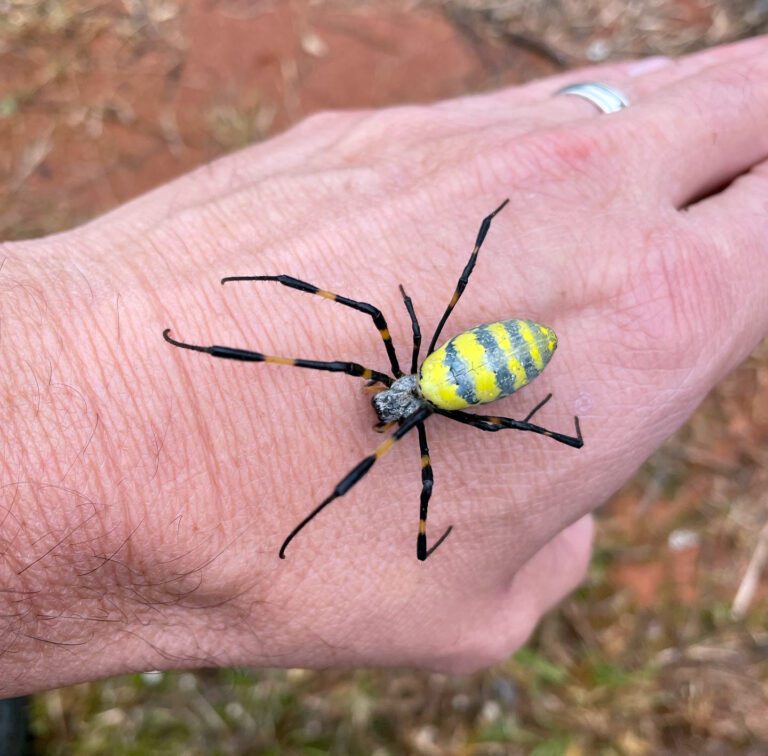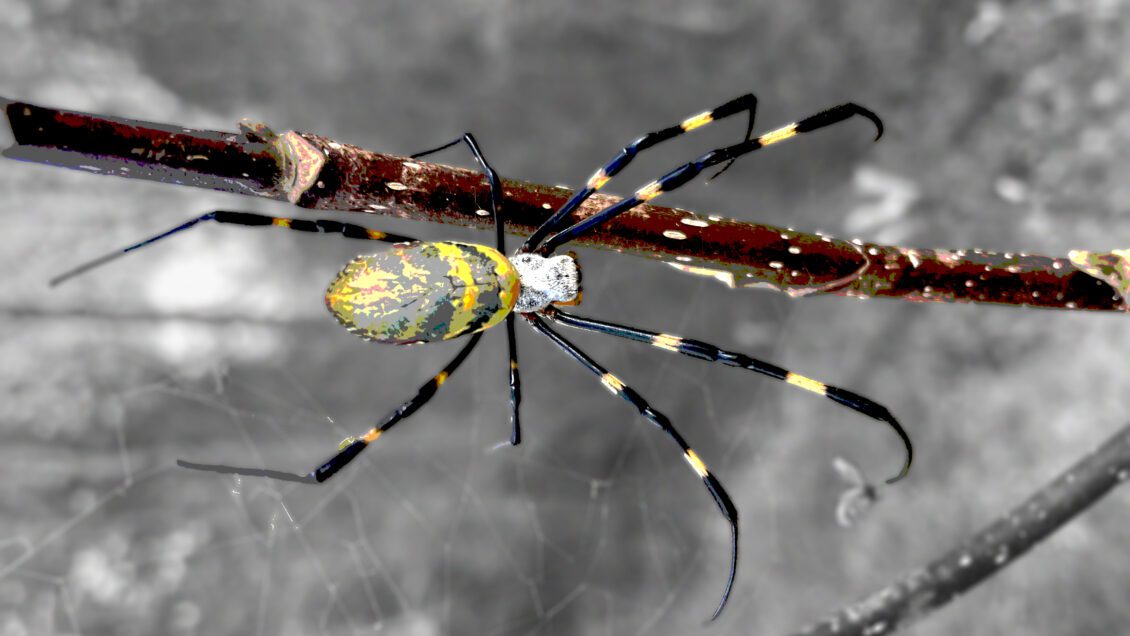First came the spotted lanternflies, then the cicadas — and now, the spiders?
The Northeast U.S. is bracing for an invasion of giant venomous spiders with 4-inch-long legs that can parachute through the air.
Here’s what you need to know about the impending arrival of Joro spiders, their potential impact, and what experts are saying.
The Arrival and Spread of Joro Spiders
Origin and Initial Invasion
Joro spiders, native to Asia, particularly Japan, were first detected in North Georgia around 2010.
Experts believe these venomous arachnids were unintentionally transported to the U.S. via international trade and cargo shipments.
By 2021, Georgia had become “ground zero” for these spiders, with sightings reported across both urban and rural areas.
New Jersey Pest Control warned earlier this year that Joro spiders are “hard to miss” due to their significant size and vibrant coloration.
The spiders have since been spreading steadily across the southeastern United States.
The theory behind their arrival points to global trade routes, but the exact means of their introduction remains unclear.
However, the “consequences of their arrival are becoming increasingly evident,” according to pest control experts.

Geographic Spread

Since their initial detection, Joro spiders have spread across the southeastern U.S., with significant populations now established in Georgia, the Carolinas, Tennessee, and even as far as Oklahoma.
There have also been sightings in Maryland, indicating their potential to spread northward.
Experts, including José R. Ramírez-Garofalo, an ecologist at Rutgers University’s Lockwood Lab, suggest that it is “a matter of when, not if” the spiders make their way to New York and New Jersey.
This sentiment is echoed by David Coyle, an invasive species expert at Clemson University, who noted, “Barring some unforeseen circumstance, we expect the range of these things to continue expanding.”
New York is “right in the middle of where they like to be,” said University of Georgia researcher Andy Davis.
This raises concerns about the imminent arrival of Joro spiders in the state.
Ecological Adaptation
Joro spiders have demonstrated a remarkable ability to adapt to various environments, including urban areas.
Unlike many other spiders, they can be found on street lamps and telephone poles, as observed by Davis.
This adaptability is a key factor in their successful spread across the U.S.
Their comfort in a wide range of environments matches well with their native range in Asia, suggesting they are well-suited to thrive in much of North America.
As invasive species expert David Coyle noted, “It shows that their comfort area in their native range matches up very well with much of North America.”
This adaptability and rapid reproduction rate have allowed them to establish themselves firmly in the southeastern U.S., and now they are poised to expand further north.
Physical Characteristics and Behavior
Distinct Appearance

Joro spiders are easily recognizable due to their striking appearance.
They have vibrant yellow and grey bodies, with females boasting a leg span of up to 4 inches.
This makes them one of the more visually striking spiders you might encounter.
Despite some reports exaggerating their size, with claims of legs spanning six to eight inches, experts like Floyd Shockley, an entomologist at the Smithsonian National Museum of Natural History, clarify that these measurements are overstated.
Shockley noted, “You’d have to stretch this thing out like a medieval torture device to get [its legs] even four inches, let alone six inches.”
Regardless of the exact measurements, their size and coloration make Joro spiders hard to miss.
Ballooning Technique
One of the most fascinating behaviors of Joro spiders is their ability to “fly” using a technique known as ballooning.
This involves releasing silk threads into the air, which are then carried by the wind, allowing the spiders to disperse over large distances.
David Coyle explained, “Right after they hatch, the little hatchlings may be the size of a sesame seed.
Some of them will get up high and they’ll raise their abdomen.
They’ll put a few strands of silk out, and some of them will get carried away by the wind.” This method of dispersal is common among many spider species, but is particularly notable in Joro spiders due to their size.
Ballooning enables young spiders to travel considerable distances, contributing significantly to their rapid spread across new territories.
Comparison with Other Spiders

Joro spiders differ from many native spiders not only in appearance but also in behavior.
Their ability to thrive in urban environments and their unique ballooning technique set them apart from other species.
Experts note that regular spiders wouldn’t be caught dead in places where Joro spiders are frequently seen, such as on street lamps and telephone poles.
This highlights their exceptional adaptability to various environments, including those heavily influenced by human activity.
Additionally, while all spiders are venomous to some extent, the venom of Joro spiders is not dangerous to humans, a characteristic they share with most native spiders.
| Characteristic | Joro Spiders | Native U.S. Spiders |
|---|---|---|
| Size | Large, up to 4-inch leg span | Varies, but generally smaller |
| Coloration | Vibrant yellow and grey | Varies, often less conspicuous |
| Ballooning | Yes, notable due to size | Yes, but less noticeable |
Impact on Local Ecosystems
Predatory Nature
In their native habitats in Asia, Joro spiders play a crucial role in controlling insect populations.
They act as natural pest controllers, preying on various insects and helping to maintain ecological balance.
However, in the U.S., their predatory nature could disrupt local ecosystems.
By preying on native insects, they could reduce the populations of certain species, potentially affecting the food web.
Experts warn that this could have a ripple effect throughout the ecosystem, altering the balance and dynamics of local biodiversity.
Competition with Native Species
The introduction of Joro spiders into new environments raises concerns about competition with native spider species.
Their ability to establish themselves quickly and efficiently could lead to displacement of native spiders.
David Coyle mentioned, “There is evidence they’re outcompeting native spider species.” This competition for resources such as food and habitat could negatively impact native spider populations.
Moreover, the presence of Joro spiders could alter the composition of local spider communities, potentially leading to a decline in native biodiversity.
Ripple Effects
The impact of Joro spiders extends beyond their immediate prey and competitors.
By affecting insect populations, they could influence other species that rely on these insects for food.
For instance, birds and other insectivores might experience changes in their food availability, which could have cascading effects throughout the ecosystem.
The full extent of these ripple effects is still being studied by ecologists.
Understanding these broader ecological impacts is crucial for developing effective management strategies and mitigating potential negative consequences.
Human Interaction and Perception
Public Fear and Misconceptions
The arrival of Joro spiders has sparked significant public fear and apprehension, largely fueled by sensationalist media coverage.
Headlines warning of “giant venomous flying spiders” have contributed to widespread panic.
Floyd Shockley expressed concern over these exaggerated descriptions, stating he was “mortified” by the sensationalist headlines.
The fear generated by such coverage often leads to misconceptions about the actual threat posed by these spiders.
It is essential to address these misconceptions and provide accurate information to alleviate public fears.
Actual Risk to Humans
While Joro spiders are venomous, their venom is not harmful to humans.
According to David Coyle, “We have no evidence that they’ve done any damage to a person or a pet.”
Their venom is primarily used to subdue prey such as butterflies, wasps, and cockroaches.
In the rare instances where Joro spiders have bitten humans, the effects are usually mild, comparable to a mosquito bite or a bee sting.
Shockley added, “The few reports of joros biting people suggest it’s like something between the itchy irritation of a mosquito bite and the pain of a bee sting.”
Understanding the actual risk is crucial in dispelling fears and promoting a more rational perspective on these spiders.
Expert Opinions
Experts emphasize that Joro spiders are generally shy and non-aggressive.
Andy Davis, a research scientist at the University of Georgia, noted, “If you leave them alone, they’ll leave you alone, and you can both go about your business.”
In fact, Davis’s research found that Joro spiders are among the most timid arachnids.
When threatened, they remain motionless for extended periods, a behavior indicating their preference to avoid conflict.
This docile nature further underscores the minimal risk they pose to humans, despite their intimidating appearance.
Scientific Research and Findings
Studies on Spread and Adaptation
Scientific research has been instrumental in understanding the spread and adaptation of Joro spiders.
Peer-reviewed studies have confirmed their potential to inhabit most of the eastern U.S., given the similarities between the climate of their native range and North America.
David Coyle’s research highlights this adaptability, showing that the spiders’ comfort area in their native habitat aligns well with many regions in the U.S.
This indicates a high likelihood of their continued spread northward.
Ongoing research aims to further understand their ecological impact and behavior, providing insights into how they might interact with local ecosystems.
Observations from Experts
Field observations and laboratory studies have provided valuable insights into the behavior and ecology of Joro spiders.
Experts have noted their rapid reproductive rates and ability to establish themselves quickly in new environments.
José R.
Ramírez-Garofalo emphasized the inevitability of their spread to New York and New Jersey, suggesting it is only a matter of time before they become established in these regions.
These observations underscore the need for ongoing monitoring and research to manage their impact effectively.
Debunking Myths
There are numerous myths and misconceptions surrounding Joro spiders, often exacerbated by sensationalist media coverage.
For instance, the notion that they can “fly” like the monkeys in The Wizard of Oz is misleading.
While they do use ballooning to disperse, this process is common among many spider species and does not equate to true flight.
Additionally, their size is often exaggerated, leading to unnecessary fear.
Addressing these myths is crucial for providing a balanced and accurate understanding of Joro spiders.
Management and Control Efforts
Pest Control Measures
Given the rapid spread of Joro spiders, pest control services play a vital role in managing their population.
Local pest control services have been active in responding to sightings and helping to mitigate their spread.
However, experts acknowledge that there are significant challenges in controlling the population of such a prolific species.
The spiders’ ability to disperse widely through ballooning makes it difficult to contain them effectively.
Despite these challenges, pest control efforts remain a crucial component of managing the impact of Joro spiders.
Public Involvement
Public involvement is essential in managing the spread of Joro spiders.
Communities are encouraged to report sightings to local pest control services and participate in educational initiatives to better understand these arachnids.
Educating the public about the actual risks and behaviors of Joro spiders can help alleviate unnecessary fears and promote more effective management strategies.
Collaboration between residents, pest control services, and ecologists is vital for addressing the challenges posed by the spread of Joro spiders.
Long-Term Solutions
In the face of the unprecedented Joro spider invasion, long-term solutions emphasize coexistence and responsible management.
As the pest control service stated, “The delicate balance of ecosystems requires a nuanced understanding of these arachnids, emphasizing coexistence and responsible management.”
Strategies for minimizing ecological disruption include targeted pest control measures, habitat management, and ongoing research to monitor their impact.
Ultimately, fostering resilient and sustainable ecosystems requires a harmonious approach to managing the presence of Joro spiders.
Case Studies and Anecdotes
Georgia as Ground Zero
Georgia served as the initial epicenter for the Joro spider invasion in the U.S.
Residents first reported sightings in 2014, and the population has since expanded significantly.
Both urban and rural areas have seen an increase in Joro spider populations.
These early reports in Georgia provided valuable insights into the spiders’ behavior and adaptability.
Observations from this region have helped shape current understanding and management strategies for dealing with the spiders.
The experiences in Georgia highlight the importance of early detection and proactive management in mitigating the spread of invasive species.
Personal Accounts
Personal accounts from residents in affected areas offer a glimpse into the everyday interactions with Joro spiders.
Many residents initially expressed fear and apprehension due to the spiders’ large size and vibrant coloration.
However, over time, some have come to appreciate their role in controlling insect populations.
For instance, Joro spiders have been observed preying on other invasive species, such as brown marmorated stink bugs and spotted lanternflies.
These personal stories underscore the importance of education and understanding in addressing public concerns about Joro spiders.
Environmental and Economic Considerations
Impact on Local Biodiversity
The introduction of Joro spiders poses potential threats to local biodiversity.
By preying on native insects, they could disrupt existing food webs and alter the composition of local ecosystems.
Ecologists are particularly concerned about the impact on native spider species, which may be outcompeted for resources and habitat.
This could lead to a decline in native biodiversity and changes in ecosystem dynamics.
Understanding these impacts is crucial for developing effective management strategies to protect local biodiversity.
Economic Implications
The economic implications of the Joro spider invasion are multifaceted.
On one hand, their presence may lead to increased costs for pest control services and ecological management efforts.
On the other hand, their role in controlling other invasive species could have positive economic impacts, particularly in agriculture, where pests like stink bugs and lanternflies cause significant damage.
Balancing these economic considerations requires a comprehensive approach that takes into account both the costs and benefits of Joro spider management.
The Future of Joro Spiders in the U.S.
Predictions and Projections
Experts predict that the range of Joro spiders will continue to expand, likely reaching further north into regions like New York and New Jersey.
This expansion is driven by their adaptability and favorable environmental conditions.
David Coyle noted that the spiders’ native range in Asia matches well with much of North America, suggesting they are well-suited to thrive in various climates across the U.S.
Continued monitoring and research will be essential to track their spread and manage their impact effectively.
Adaptation to Climate and Environment
One key area of ongoing research is the Joro spiders’ ability to adapt to different climates, particularly the colder winters of the northeastern U.S.
While they have not yet been observed in these regions, their potential to survive and establish populations remains a topic of interest.
David Coyle remarked, “We still don’t really know anything about how they would [survive] northeastern winters, because obviously they’re not there yet.”
This research will help inform management strategies and predict the future distribution of Joro spiders across the country.
Conclusion
As Joro spiders continue their journey across the eastern U.S., it’s up to all of us to stay informed, participate in research and management efforts, and approach these arachnids with a mix of caution and curiosity.
Who knows, you might just find yourself marveling at a colorful, palm-sized spider floating by on a silken thread.
Just remember, they’re more afraid of you than you are of them!

